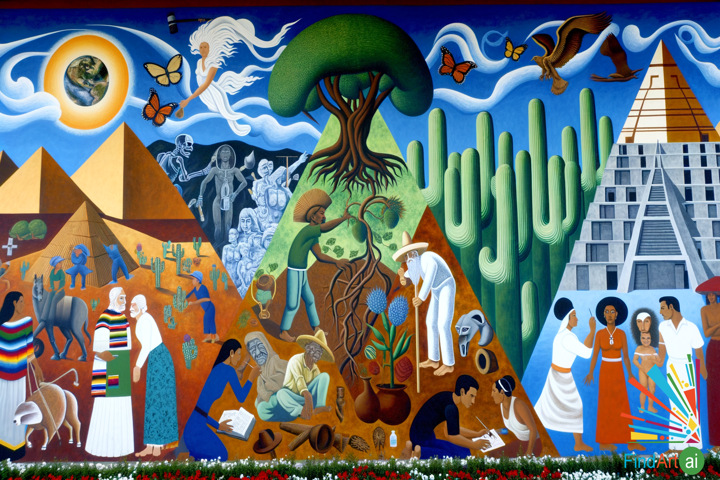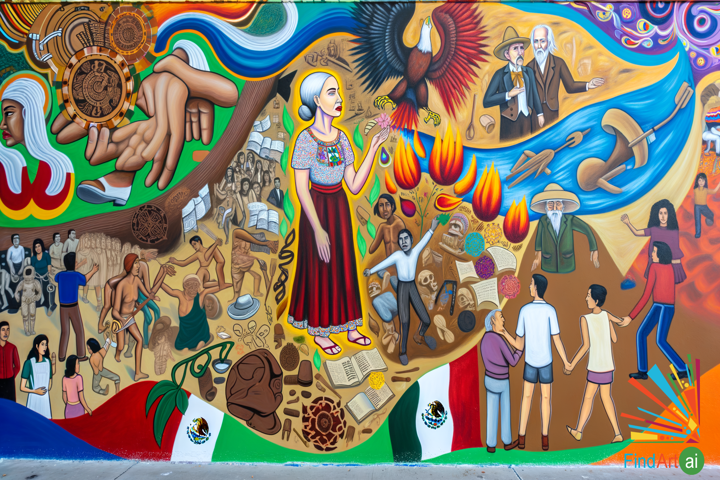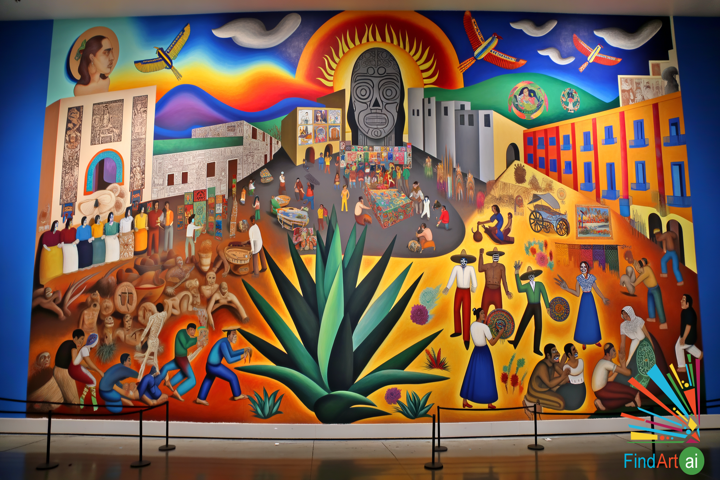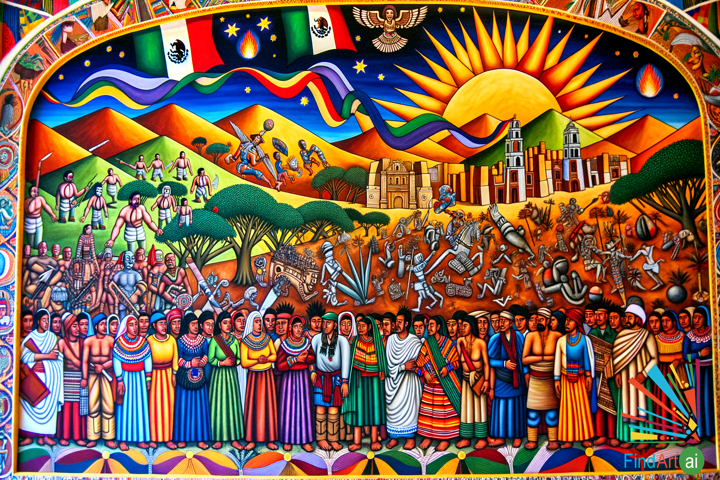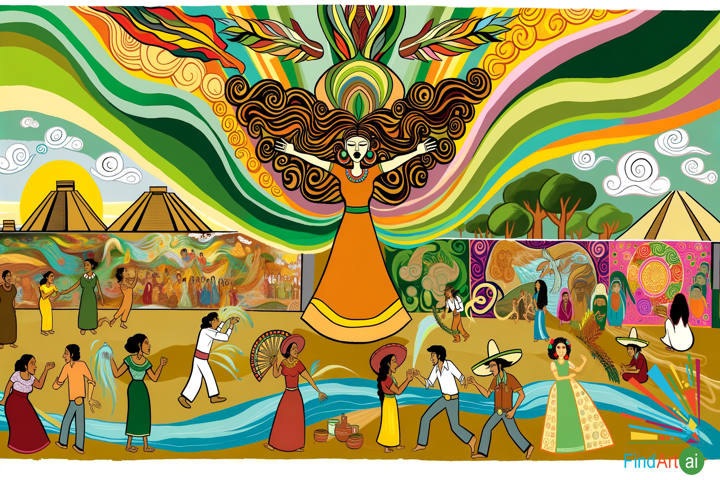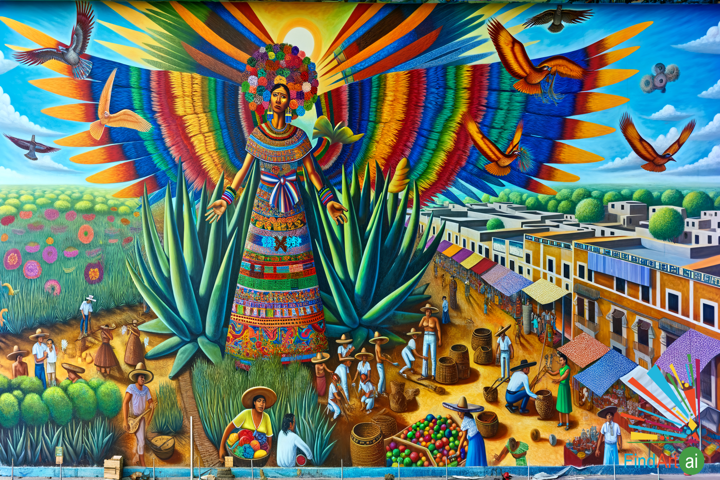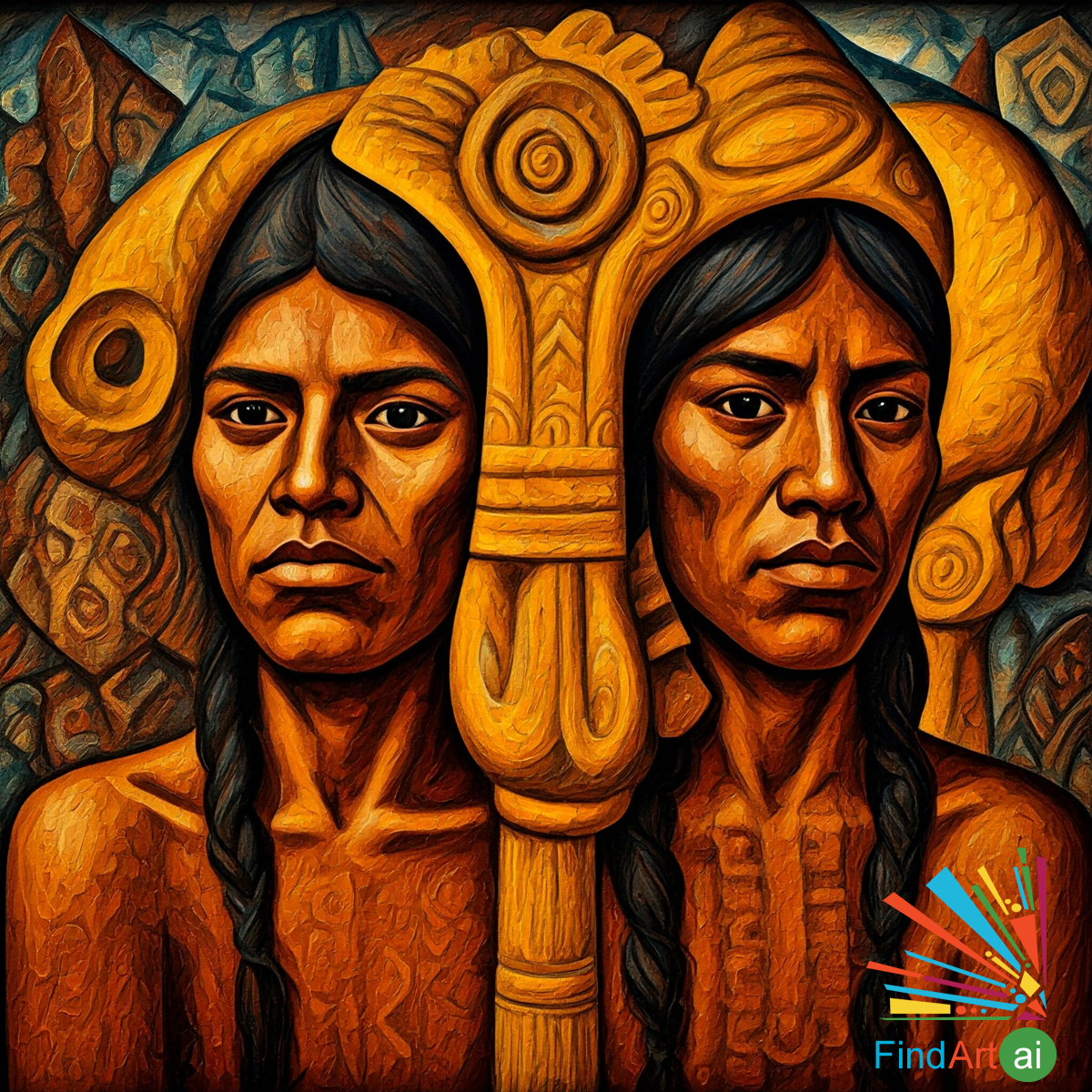
Mexican Muralism Paintings with Cultural Identity Theme
Mexican Muralism with the Cultural Identity theme is characterized by large-scale, public paintings that reflect the rich cultural heritage, history, and social struggles of the Mexican people. Developed in the early 20th century after the Mexican Revolution (1910–1920), this movement sought to create an artistic expression that celebrated Mexico's indigenous roots, historical events, and the working class, while also addressing social and political issues. Artists like Diego Rivera, José Clemente Orozco, and David Alfaro Siqueiros were central figures in this movement, using murals to convey messages of national pride, unity, and the complex layers of Mexican identity.
Key Characteristics of Mexican Muralism with the Cultural Identity Theme
- Indigenous Heritage
- Mexican Muralism often emphasizes the importance of Mexico’s indigenous history and traditions, depicting pre-Columbian civilizations such as the Aztecs and Mayans as symbols of strength and cultural continuity. These depictions underscore the pride in Mexico’s indigenous roots and challenge the dominance of European colonial narratives.
- Example: Diego Rivera’s murals frequently feature images of indigenous people, agricultural laborers, and ancient temples, illustrating their central role in the country’s cultural identity.
- Post-Revolutionary Ideals
- The Mexican Revolution, which aimed to address inequality and social injustice, heavily influenced muralists. Their paintings often highlight the struggles of the working class, peasants, and indigenous communities, reflecting the ideals of social reform, equity, and national unity.
- Example: Murals may depict scenes of the revolution itself, with powerful imagery of workers rising up against oppression, as seen in José Clemente Orozco’s "Prometheus," which conveys revolutionary ideals and the desire for enlightenment.
- Nationalism and Cultural Unity
- Mexican Muralism seeks to build a sense of national identity that blends indigenous, mestizo (mixed-race), and Spanish influences, promoting a vision of Mexico as a united and resilient nation. This focus on cultural unity is often conveyed through grand, symbolic imagery that connects past and present.
- Example: Rivera’s murals in the National Palace of Mexico combine historical figures like the Aztec emperor Cuauhtémoc and revolutionary leader Emiliano Zapata, creating a cohesive narrative that links Mexico’s indigenous heritage with its modern revolutionary spirit.
- Vivid, Symbolic Imagery
- Mexican muralists employed bold, vibrant colors and dynamic compositions to create large, visually impactful works that could be easily understood by a wide audience. Their use of symbolism—such as the Mexican eagle, the sun, and indigenous deities—reinforced messages of cultural identity and national pride.
- Example: The Mexican eagle, a national symbol, is often depicted as rising from the earth or clashing with oppressors, representing the strength and resilience of the Mexican people.
- Public Art for the People
- Unlike traditional easel paintings, Mexican Muralism was intended to be accessible to everyone, especially the working class. Murals were often placed in public buildings, schools, and government offices, where ordinary people could encounter them in their daily lives. This democratization of art was essential to reinforcing a shared sense of cultural identity.
- Example: The murals at the Ministry of Public Education in Mexico City, painted by Diego Rivera, are filled with scenes of Mexican life, labor, and history, making art and cultural pride available to the masses.
- Focus on Mexican History
- Muralists frequently depicted significant events from Mexico’s history, including the pre-Columbian era, the Spanish conquest, and the Mexican Revolution. These historical narratives served to reclaim and celebrate Mexico’s past while also critiquing colonialism and foreign intervention.
- Example: Orozco’s murals often explore the darker aspects of Mexican history, portraying the brutality of the Spanish conquest and the exploitation of indigenous peoples, but also highlighting their enduring spirit.
- Depiction of the Working Class
- A key element of Mexican Muralism is the portrayal of the working class as the backbone of the nation. Murals frequently depict peasants, laborers, and indigenous people engaged in productive work, reinforcing the idea that cultural identity is rooted in the everyday experiences and struggles of ordinary people.
- Example: Rivera’s "Man at the Crossroads" shows a worker at the center of the composition, surrounded by scenes of industry, agriculture, and revolutionary struggle, symbolizing the working class’s pivotal role in shaping Mexico’s future.
- Anti-Imperialism and Social Justice
- Many murals carry strong political messages, critiquing imperialism, capitalism, and foreign interference in Mexico’s affairs. These themes align with the larger project of asserting Mexican cultural identity in opposition to foreign dominance.
- Example: David Alfaro Siqueiros’ works often depict the suffering caused by imperialism and capitalism, with figures of the oppressed rising up to claim their rights and cultural identity.
Common Themes in Mexican Muralism with Cultural Identity
- The Fusion of Indigenous and Spanish Cultures
- Murals often explore the complex relationship between Mexico’s indigenous heritage and the legacy of Spanish colonialism, highlighting both the tension and the fusion of these cultural influences in forming modern Mexican identity.
- Example: Rivera’s murals may show an indigenous figure standing beside a Spanish colonizer, illustrating the conflict and eventual blending of these two cultures into a new mestizo identity.
- Glorification of the Mexican Landscape
- The natural landscape of Mexico, with its mountains, rivers, and agricultural fields, is often used as a backdrop in murals, symbolizing the connection between the Mexican people and their land. The land is depicted as a source of life, sustenance, and cultural continuity.
- Example: Scenes of peasants working in cornfields or harvesting crops are common, emphasizing the deep ties between Mexican identity and the earth.
- Revolutionary Heroes as Cultural Icons
- Leaders of the Mexican Revolution, such as Emiliano Zapata and Pancho Villa, are frequently depicted as symbols of resistance and cultural pride. Their images in murals often represent the ongoing struggle for social justice and the empowerment of the Mexican people.
- Example: Zapata may be shown leading a group of peasants in a revolt, holding a banner of the Virgin of Guadalupe, a symbol of both religious and cultural identity.
Roots of Resonance: A Vibrant Mural Celebrating Mexican Culture and Identity
"Roots of Resonance" is a vibrant mural celebrating Mexican cultural identity through Mexican Murali...
Roots of Resilience: A Mural Celebrating Mexican Culture Through Time and Vibrant Imagery
"Roots of Resilience" is a mural celebrating Mexican cultural identity, weaving past, present, and f...
Echoes of Heritage: A Mural Celebrating Mexican Identity with History and Modernity
"Echoes of Heritage" is a vibrant mural celebrating Mexican cultural identity. Central to the piece ...
Echoes of Heritage: A Mexican Mural Capturing Culture, Unity, and History
"Echoes of Heritage: A Mexican Muralism Journey" is a vibrant mural capturing Mexico's rich cultural...
Vibrant Mural Celebrates Mexico's Heritage and Unity Through Mother Earth Symbolism
"Tapestry of Ancestry: The Heartbeat of a Nation" is a monumental mural capturing the essence of Mex...
Threads of Heritage: A Mural Celebrating Mexico's Cultural Identity and Unity
"Threads of Heritage" is a grand mural that embodies Mexican cultural identity through Mexican Mural...

